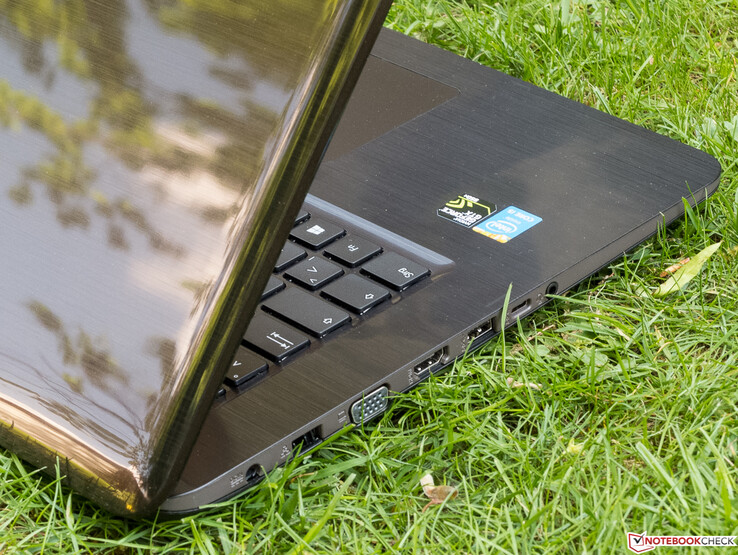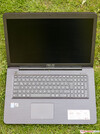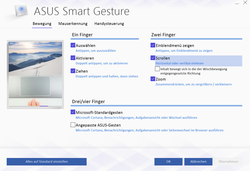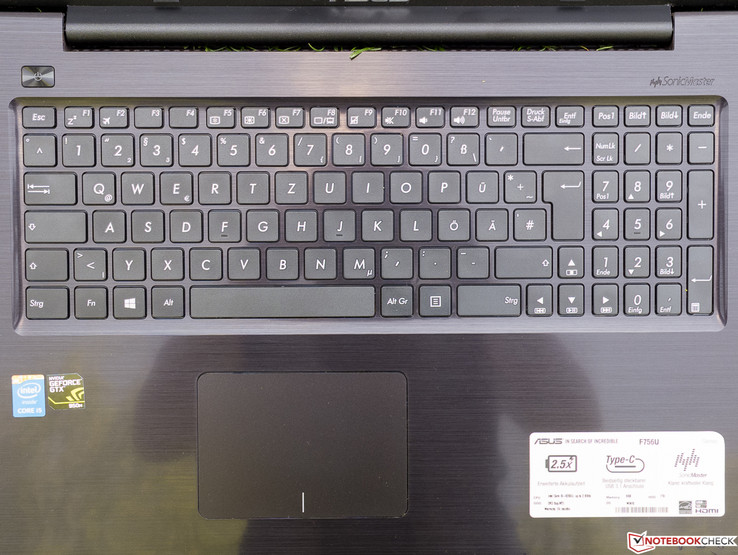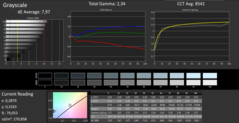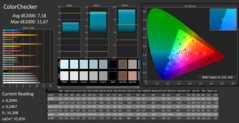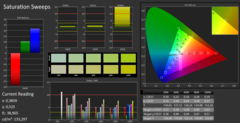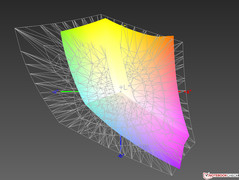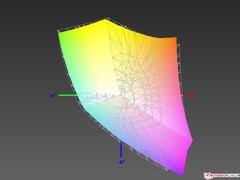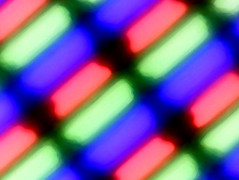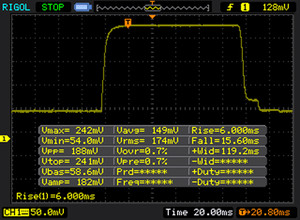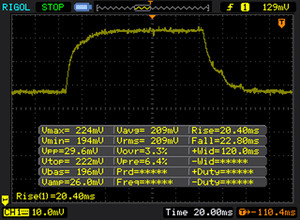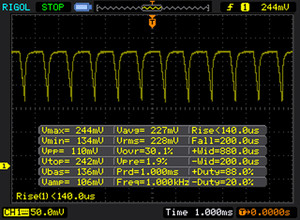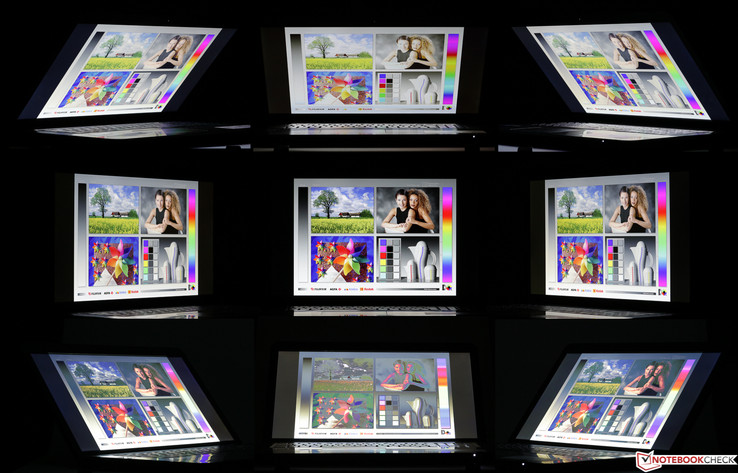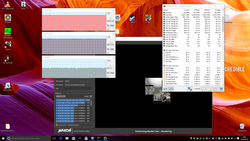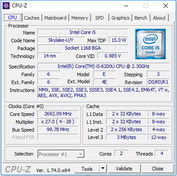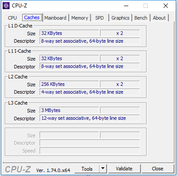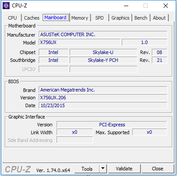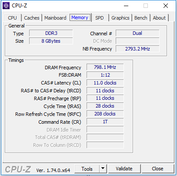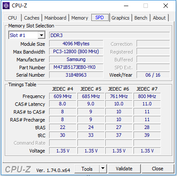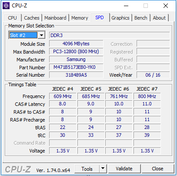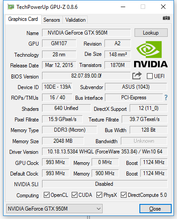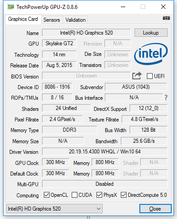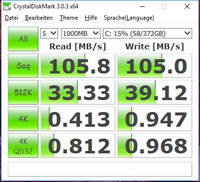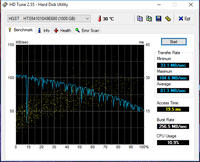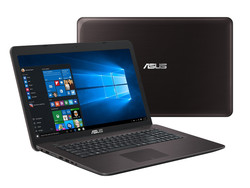Asus F756UX-T7013T Notebook Review

For the original German review, see here.
Asus' new F756UX that we are testing in the T7013T version is a 17-inch multimedia suitable desktop replacement that is also designed for gamers with lowered demands thanks to its Nvidia GeForce GTX 950M with 2 GB of dedicated memory. Three models were listed on a major Berlin-based price comparison site at test time, which only differed in CPU and storage device. The review sample as the lowest priced version starting at around 770 Euros (~$864) features an Intel Core i5-6200U and a conventional 1 TB hard drive. The T7014T model (starts at approx. 840 Euros/~$942) combines a somewhat faster i7-6500U with the same HDD as in the review sample. The i7 is also found in the T7016T version (starts at 1000 Euros/~$1122), but it also sports a 128 GB SSD alongside the said drive. The surcharge of 160 Euros (~$179) is perhaps a bit too high for the low capacity. All other key specs are identical: Full HD panel, GTX 950M, 8 GB of RAM, DVD burner and 38 Wh battery.
We selected 17-inch laptops for comparison that are also found in the multimedia corner and that are on the same price level as the review sample. Since this format has become rare, we had to fall back on devices with Intel's Core i7-6500U. It starts with Medion's Erazer P7644 that is the only laptop with an SSD + HDD in the test, but it also only costs 900 Euros (~$1010). The approximately 950 Euro (~$1066) HP ProBook 470 G3 is next; its special feature is AMD's Radeon R7 M340 (2 GB) graphics card. The third opponent is HP's Pavilion 17-g120ng with a GeForce 940M for 900 Euros upward. Both the Medion and HP Pavilion sport IPS-based panels, and the ProBook as well as the review sample rely on TN.
Case
As mentioned in the lead in, Asus' relies on high-gloss plastic surfaces for the display back and base upper side. They provide an astonishing grip and feature a kind of subtle brushed-metal pattern in the background. Although the colors are based on black, they shift to purple or bronze depending on the ambient light. Fingerprints are not noticed much thanks to the pattern under the finish. The design can be described as rather basic and serious, apart from the eye-catching surfaces and strongly curved corners.
Our warping attempts produced extreme cracking noises in the somewhat unstable-looking area of the DVD tray. The casing's stiffness was satisfactory otherwise. That, but not more, is also true for the build. Mostly even gaps and only few, slightly protruding edges correspond to the standard that can be expected in this price range. The lid is fairly pressure resistant and relatively thick without making a really stiff impression. The lid rocks marginally when opening up the notebook.
Connectivity
Highlights like DisplayPort or Thunderbolt are usually only found in higher price ranges, and they are absent in the F756UX. In return, an old-fashioned VGA port and one USB 3.1 Type-C are installed besides the common minimum standard. Asus has not forgotten a fold-out Ethernet port for stationary use. Two of the conventional USB ports still operate in the 2.0 standard. Both USB 2.0 ports predestined for connecting e.g. an external mouse have been installed in the very far front right where the cable would get in the way of right-handed users.
We use our Toshiba Exceria Pro SDXC 64 GB UHS-II reference SD card for evaluating the card reader's performance. The maximum transfer rate is 39 MB/s when copying large data blocks, and just 27 MB/s can be counted with when transferring standard JPG image files of approximately 5 MB each.
Communication
Asus saves on Wi-Fi and installs a Qualcomm/Atheros module that only supports the traditional 802.11 b/g/n (1x1) standards, integrates Bluetooth 4.0 and cannot transmit in the less frequented 5 GHz band. The reception in the tester's personal test setup proved unexceptional. It is, however, recommendable to perform a test onsite in regions with very critical Wi-Fi coverage within the deadline for returning the laptop.
Accessories
We did not expect special accessories in view of the relatively low price, and we did not find any, either. Apart from the compulsory power supply, only a quick start guide and warranty notes were found in the box. At test time, we did not discover any optional accessories exclusively designed by the manufacturer for the F756UX lineup. Since recovery media is not included, the user should not tamper with the 499 MB recovery partition.
Maintenance
Both filled memory banks can be accessed via a maintenance hatch secured by a concealed screw. The other components, including the battery, can only be accessed after removing the base plate, which is secured by another ten screws.
Warranty
Asus provides the original buyer a 24-month manufacturer warranty from date of purchase. The warranty on the battery is limited to 12 months. Further information can be found in the warranty conditions.
Input Devices
Touchpad
The slightly roughened ClickPad without dedicated keys can be said to have impeccable gliding qualities even when the fingers are lightly moist. The tester did not have any problems with the relatively small format in relation to the dimensions. Fast movements are implemented and the accuracy does not give reason for complaint. Unfortunately, it does not look as good with drag & drop via double tapping, which was not at all reliable. Both replacement mouse keys with a short drop have, in the tester's opinion, pleasant resistance, a very crisp pressure point and they produce a clearly audible feedback.
Keyboard
The unlit and void of status LEDs keyboard is not bad, but we cannot recommend Asus' laptop to prolific writers, either. A spongy typing feel evolves not least due to the imperfect stability in the center. The flat, roughened and impeccably lettered keys do not have much drop although the size would have allowed for more. We would not describe the pressure point as crisp although it is good enough.
In addition to the once again unfortunately scaled down keypad that forces large hands into a cramped position and consequently loses a part of its usefulness, the layout does not have any special highlights. The available room has been used well. Neither the keys nor the spacing is too small. A clear sound is produced when typing on the keyboard, which limits use in noise-sensitive environments.
Display
Asus has opted for a matte, TN-based Full HD panel. Approximately two million pixels distributed over 17.3 inches result in a not very lush pixel density of 127 PPI. That could already slightly annoy sharp-sighted users at a distance of half a meter (~20 in). Apart from that, the image sharpness is impeccable. Screen alternatives were not available at test time. The maximum brightness of around 270 cd/m² is not a top rate, but is acceptable in this price range. The rivals in our test are all a bit brighter. The illumination of 83% has to be called below average, and is sometimes also confirmed subjectively. Although a striking backlight bleeding or glow effect is not visible on an absolutely black screen, some areas look marginally brighter than others.
| |||||||||||||||||||||||||
Brightness Distribution: 83 %
Center on Battery: 265 cd/m²
Contrast: 1576:1 (Black: 0.17 cd/m²)
ΔE ColorChecker Calman: 7.18 | ∀{0.5-29.43 Ø4.78}
ΔE Greyscale Calman: 7.97 | ∀{0.09-98 Ø5}
94% sRGB (Argyll 1.6.3 3D)
59% AdobeRGB 1998 (Argyll 1.6.3 3D)
64.6% AdobeRGB 1998 (Argyll 3D)
93.7% sRGB (Argyll 3D)
63.9% Display P3 (Argyll 3D)
Gamma: 2.34
CCT: 8541 K
The screen's pleasingly low black level of just 0.17 cd/m², which is in line with the subjective impression of rich black, leads to a tremendous and exemplary contrast ratio of 1576:1. Despite the slightly higher brightness, the opponents in the test cannot keep up due to their brighter black levels. Our review sample presented the highest color shift in the field in delivery state. DeltaE rates of 7 to 8 (ideal: less than 3) are still acceptable for TN conditions, but would be below average for IPS panels. Using the profile linked in the box could eliminate the observed, minor cyan color tint.
High color space coverage is now found in more and more TN panels compared with the past. Users who work (semi) professionally with images will be interested in the relatively high AdobeRGB coverage of 59 percent. Even the much smaller and highly distributed sRGB standard color space is covered by at least 90%. That paves the way for ambitious image editing on hobby level after calibrating and profiling.
| Asus F756UX-T7013T | Medion Erazer P7644 | HP ProBook 470 G3 | HP Pavilion 17-g120ng | |
|---|---|---|---|---|
| Display | -2% | 1% | 4% | |
| Display P3 Coverage (%) | 63.9 | 63.4 -1% | 65.1 2% | 65.7 3% |
| sRGB Coverage (%) | 93.7 | 90.3 -4% | 92 -2% | 97.6 4% |
| AdobeRGB 1998 Coverage (%) | 64.6 | 64.5 0% | 66.5 3% | 67.7 5% |
| Response Times | -43% | 2% | -93% | |
| Response Time Grey 50% / Grey 80% * (ms) | 42 ? | 48 ? -14% | 35 ? 17% | 70 ? -67% |
| Response Time Black / White * (ms) | 21 ? | 36 ? -71% | 24 ? -14% | 46 ? -119% |
| PWM Frequency (Hz) | 1000 ? | 50 ? | 200 ? | |
| Screen | -17% | 2% | 3% | |
| Brightness middle (cd/m²) | 268 | 296 10% | 314 17% | 309 15% |
| Brightness (cd/m²) | 255 | 280 10% | 291 14% | 292 15% |
| Brightness Distribution (%) | 83 | 87 5% | 88 6% | 86 4% |
| Black Level * (cd/m²) | 0.17 | 0.48 -182% | 0.32 -88% | 0.27 -59% |
| Contrast (:1) | 1576 | 617 -61% | 981 -38% | 1144 -27% |
| Colorchecker dE 2000 * | 7.18 | 4.71 34% | 3.43 52% | 4.53 37% |
| Colorchecker dE 2000 max. * | 11.67 | |||
| Greyscale dE 2000 * | 7.97 | 5.17 35% | 3.72 53% | 5.66 29% |
| Gamma | 2.34 94% | 2.33 94% | 2.39 92% | 2.62 84% |
| CCT | 8541 76% | 7613 85% | 6764 96% | 7893 82% |
| Color Space (Percent of AdobeRGB 1998) (%) | 59 | 59 0% | 59.8 1% | 62 5% |
| Color Space (Percent of sRGB) (%) | 94 | 90 -4% | 92 -2% | 98 4% |
| Total Average (Program / Settings) | -21% /
-17% | 2% /
2% | -29% /
-11% |
* ... smaller is better
We could perform our outdoor test in bright sunshine this time, which is of course a big challenge for the F756UX. Thanks to the matte and bright screen, working in the shade (right screenshot) is no problem, and experience shows that this is not even necessary on cloudy days when positioned carefully. As the left screenshot illustrates, legibility is very limited under lateral sunlight. Regardless of that, a laptop of this size will unlikely be used outdoors very often.
Display Response Times
| ↔ Response Time Black to White | ||
|---|---|---|
| 21 ms ... rise ↗ and fall ↘ combined | ↗ 6 ms rise | |
| ↘ 15 ms fall | ||
| The screen shows good response rates in our tests, but may be too slow for competitive gamers. In comparison, all tested devices range from 0.1 (minimum) to 240 (maximum) ms. » 45 % of all devices are better. This means that the measured response time is similar to the average of all tested devices (20.2 ms). | ||
| ↔ Response Time 50% Grey to 80% Grey | ||
| 42 ms ... rise ↗ and fall ↘ combined | ↗ 20 ms rise | |
| ↘ 22 ms fall | ||
| The screen shows slow response rates in our tests and will be unsatisfactory for gamers. In comparison, all tested devices range from 0.165 (minimum) to 636 (maximum) ms. » 66 % of all devices are better. This means that the measured response time is worse than the average of all tested devices (31.6 ms). | ||
Screen Flickering / PWM (Pulse-Width Modulation)
| Screen flickering / PWM detected | 1000 Hz | ≤ 90 % brightness setting | |
The display backlight flickers at 1000 Hz (worst case, e.g., utilizing PWM) Flickering detected at a brightness setting of 90 % and below. There should be no flickering or PWM above this brightness setting. The frequency of 1000 Hz is quite high, so most users sensitive to PWM should not notice any flickering. In comparison: 53 % of all tested devices do not use PWM to dim the display. If PWM was detected, an average of 8111 (minimum: 5 - maximum: 343500) Hz was measured. | |||
Viewing angle stability is still not a strength of TN panels, but they continue to improve. The color reproduction mostly remains true when looking at the screen horizontally from the sides, and only the contrast and brightness significantly decrease. The elbowroom is much tighter vertically but is still relatively wide for a TN panel. Consequently, the slightest change in position does not lead to an extremely distorted presentation. The limit is naturally reached when the viewing angles are shifted somewhat unrealistically on both levels, as the corner photos in our collage show.
Performance
Processor
Despite gaming ambitions, a Hyperthreading, dual-core CPU that is only conditionally suitable from Intel's latest Skylake generation is installed. The Core i5-6200U (2x 2.3 - 2.8 GHz; TDP: 15 W) is, like the direct Haswell and Broadwell predecessors, an extremely popular and very frugal processor that is found for example in countless office laptops, and which can cope with more demanding software. The specified Turbo frequency when both cores are loaded is 2.7 GHz. This was also maintained stably in our Cinebench R15 loop that produces a high yet realistic CPU load.
The processor integrates a frugal GPU called Intel HD 520 that automatically takes care of 2D applications thanks to Nvidia Optimus, while the GTX 950M is enabled for example in games. A noteworthy innovation is that the integrated memory controller now supports DDR4 RAM in addition to improved Hyperthreading and marginally higher performance. The CPU delivers the expected scores in the single-core benchmark of CB R15 that do not change in battery mode. The rivals in our test have a slight advantage with their higher clocking i7-6500U (2x 2.5 - 3.1 GHz; Hyperthreading; TDP: 15 W), but cannot take a significant lead. Multiple benchmarks concerning many laptop CPUs can be found in our FAQ section.
| Cinebench R15 | |
| CPU Multi 64Bit | |
| HP ProBook 470 G3 | |
| Medion Erazer P7644 | |
| HP Pavilion 17-g120ng | |
| Asus F756UX-T7013T | |
| CPU Single 64Bit | |
| HP ProBook 470 G3 | |
| Medion Erazer P7644 | |
| HP Pavilion 17-g120ng | |
| Asus F756UX-T7013T | |
System Performance
As is often the case, it is not the processor or memory configuration standing in the way of smooth gameplay, but the lack of an SSD. Only Medion's Erazer sports one among the opponents in the test. Thus, cold starts take a bit longer and the (initial) launching of programs after booting causes the one or other short lag depending on the size. Extensive multitasking with Chrome was no challenge for the laptop; switching between simultaneously opened programs was fast. We added to the comparison, as a benchmark reference, the popular Acer Aspire V Nitro Black Edition VN7-792G-74Q4 with a real quad-core (i7-6700HQ), SSD and GTX 960M (approx. 1200 Euros/~$1346).
In contrast to the outdated PCMark 7, the newer PCMark 8 places considerably less value on storage device performance so that otherwise comparably equipped laptops, with and without SSDs, are much closer here. The reason why our review sample takes the last place here is likely the somewhat weaker CPU compared with the ones in the rivals, and not the relatively low-performance hard drive. As expected, the considerably more expensive Acer takes the lead with an advantage of 17 to 19% on the review sample.
| PCMark 8 | |
| Home Score Accelerated v2 | |
| Acer Aspire V Nitro Black Edition VN7-792G-74Q4 | |
| HP ProBook 470 G3 | |
| Medion Erazer P7644 | |
| Asus F756UX-T7013T | |
| Work Score Accelerated v2 | |
| Acer Aspire V Nitro Black Edition VN7-792G-74Q4 | |
| Medion Erazer P7644 | |
| HP ProBook 470 G3 | |
| Asus F756UX-T7013T | |
| PCMark 8 Home Score Accelerated v2 | 3162 points | |
| PCMark 8 Work Score Accelerated v2 | 3969 points | |
Help | ||
Storage Device
Thanks to its SSD, Medion's Erazer P7644 is naturally the star of the test group. The rivals are simply not competitive with their conventional hard drives in terms of storage device performance. 106 MB/s in sequential read of large, related files (CrystalDiskMark 3.0) for the Asus HGST Travelstar drive only marginally surpasses the average of comparable drives. The performance in reading small, random block (4K Read) particularly important for OS and program starts is also average. The same HDD is installed in HP's 250 G4 T6P08ES, but is 26% faster in terms of 4K read performance. The storage devices of the HDD-based rivals are roughly on par with our review sample in total.
| Asus F756UX-T7013T HGST Travelstar 5K1000 HTS541010A9E680 | Medion Erazer P7644 Phison 256GB PC3110-S10C | HP ProBook 470 G3 WDC Scorpio Blue WD10JPVX-75JC3T0 | HP Pavilion 17-g120ng Toshiba MQ01ABD100 | |
|---|---|---|---|---|
| CrystalDiskMark 3.0 | 15221% | 16% | -10% | |
| Read Seq (MB/s) | 105.8 | 511 383% | 111.4 5% | 104.6 -1% |
| Read 4k (MB/s) | 0.413 | 32.35 7733% | 0.434 5% | 0.358 -13% |
| Read 4k QD32 (MB/s) | 0.812 | 305.7 37548% | 1.126 39% | 0.679 -16% |
Graphics Card
Nvidia's mid-range GeForce GTX 950M furnished with 2 GB of dedicated memory has been on the market for about one year. The DDR3 version is installed here, which is 10 to 20% slower than the GDDR5 model (914 MHz) although the GPU clock has been increased slightly to 993 MHz. The memory bus width is 128 bits in both cases, and DirectX 11 is just as supported as decoding 4K H.264 videos in the hardware. More information concerning the card can be found in our FAQ section.
Compared with all previously tested laptops based on the GTX 950M (both versions), Asus' F756UX achieves the second lowest score in 3DMark 11. However, the leader's advantage is also only 13% while the average is missed by approximately 7%. Our Medion only accomplishes a 3% lead, the GTX 960M in Acer's Nitro manages a roughly one-third higher score. The graphics power drops clearly by about half in battery mode, making mobile gaming rather improbable.
| 3DMark 11 - 1280x720 Performance GPU | |
| Acer Aspire V Nitro Black Edition VN7-792G-74Q4 | |
| Medion Erazer P7644 | |
| Asus F756UX-T7013T | |
| HP Pavilion 17-g120ng | |
| HP ProBook 470 G3 | |
| 3DMark 11 Performance | 3846 points | |
| 3DMark Cloud Gate Standard Score | 8906 points | |
| 3DMark Fire Strike Score | 2541 points | |
Help | ||
Gaming Performance
Many games from 2013 to 2015 often run smoothly in high resolutions in 1366x768 pixels and rarely in Full HD depending on the requirements. As the benchmark chart below shows, the limit is usually reached in medium settings (1366x768) in newer and/or very demanding games. Users who like to play isometric games, such as "Diablo III", "StarCraft II (Legacy of the Void)" or "FIFA" can often enjoy the full graphical beauty.
| low | med. | high | ultra | |
|---|---|---|---|---|
| BioShock Infinite (2013) | 122 | 82.8 | 69.7 | 24.9 |
| The Witcher 3 (2015) | 55.1 | 33 | 17.5 | |
| XCOM 2 (2016) | 50.2 | 19.8 | 13.3 | |
| The Division (2016) | 50.3 | 37 | 18 | 13.6 |
| Hitman 2016 (2016) | 38.2 | 34.6 | 20.9 | 19.7 |
Emissions
System Noise
Not loud, but annoying: Hard drive noises are constantly audible even at a distance of approximately one meter (~3 feet) in quiet environments. Since the market holds tons of HDDs where this is not the case, the manufacturer has opted for the wrong model from a customer's point of view.
The fan runs continually in idle mode (energy profile "High Performance" with enabled system cooling guidelines), but is only noticed when putting the ear up close. That does not change when browsing or working. It takes a moment before the fan blades slowly speed up, seemingly without breaks, when putting Asus' laptop under high stress via Prime95 (CPU) and FurMark (GPU). The maximum volume is characterized by a subtle noise without annoying side noises, but which are still clearly audible at a distance of over five meters (~16 feet). Users who want it a bit quieter will be better off with the Medion or HP's laptop.
Noise level
| Idle |
| 32.4 / 32.6 / 32.6 dB(A) |
| HDD |
| 32.7 dB(A) |
| DVD |
| 37.4 / dB(A) |
| Load |
| 42 / 45.2 dB(A) |
 | ||
30 dB silent 40 dB(A) audible 50 dB(A) loud |
||
min: | ||
Temperature
It is rather unlikely that someone will want to play graphically demanding games with a 17-inch machine on their lap, but if they do, the maximum surface temperatures of 51 °C (123.8 °F) produced via the stress test on the underside will hardly be reached. In case it does, it will get a bit unpleasant. When the device is placed on a table, only the wrist rest temperatures are important, and they never surpassed uncritical 30 °C (86 °F, idle: 27 °C/80.6 °F).
The CPU clock rates dropped slightly and fluctuated between 2.3 and 2.4 GHz after a while in the course of the above-mentioned CPU/GPU stress test. That does not indicate throttling; the Turbo utilization proves to be a bit less than ideal in this unrealistic extreme scenario though. The CPU core temperatures never reached more than 87 °C (188.6 °F).
(±) The maximum temperature on the upper side is 42 °C / 108 F, compared to the average of 36.9 °C / 98 F, ranging from 21.1 to 71 °C for the class Multimedia.
(-) The bottom heats up to a maximum of 50.5 °C / 123 F, compared to the average of 39.2 °C / 103 F
(+) In idle usage, the average temperature for the upper side is 25 °C / 77 F, compared to the device average of 31.3 °C / 88 F.
(+) The palmrests and touchpad are cooler than skin temperature with a maximum of 29.9 °C / 85.8 F and are therefore cool to the touch.
(±) The average temperature of the palmrest area of similar devices was 28.7 °C / 83.7 F (-1.2 °C / -2.1 F).
Speakers
Even a low-priced multimedia laptop should offer a good sound and our Asus laptop meets expectations. The maximum volume that we used for playing our music medley is easily enough to fill a medium-sized room with sound. Really deep basses are not audible, but they are reproduced quite decently in higher pitches. A rich, dynamic and relatively natural sound that is sometimes a bit sharp is produced. Even hints of surround sound are noticed when the right music piece is selected (Enya: "May It Be").
Differentiating instruments suffers only slightly in bass-heavy metal music with several E-guitars, drums and bass. In return, audible volume fluctuations were noticed unfavorably (and only in comparable music). Voices in videos and sound effects in games are conveyed well.
Energy Management
Power Consumption
Although HDDs consume more power than SSDs, the Medion proves to be the power-guzzler in the three idle modes in the test field. HP's Pavilion is the most frugal laptop, here and also during load, despite its i7. The relatively high differences between the devices with GTX 950M on the one hand, and the 940M and AMD Radeon R7 M340 on the other, illustrate that the plus in consumption is largely due to the stronger graphics cards. In view of a maximum consumption of 84 watts, the 90-watt power supply is just sufficiently sized.
| Off / Standby | |
| Idle | |
| Load |
|
Key:
min: | |
Battery Runtime
When comparing all 17-inch multimedia laptops tested in the past 10 months, we can say that the review sample has an almost average idle runtime using minimum brightness (see box). That is just as true for high load conditions and maximum brightness. It looks worse when we apply our practical Wi-Fi test (Our test criteria). The relatively small 38 Wh battery is noticed here especially in view of the laptop's size. However, that will be rather unimportant for the normal case of stationary use.
Only the thirsty Medion laptop (48 Wh) can boast considerably more capacity in the test field. The ProBook 470 G3 brings 44 Wh, and the Pavilion only has 41 Wh. That matches the fact that these two devices run a bit longer in the Wi-Fi test, and the Medion places itself at the top with 70 minutes more.
| Asus F756UX-T7013T | Medion Erazer P7644 | HP ProBook 470 G3 | HP Pavilion 17-g120ng | |
|---|---|---|---|---|
| Battery runtime | 33% | 12% | 19% | |
| Reader / Idle (h) | 8.2 | 8.2 0% | ||
| WiFi v1.3 (h) | 3.6 | 4.8 33% | 4.6 28% | 4.3 19% |
| Load (h) | 1.3 | 1.4 8% | ||
| H.264 (h) | 4.5 |
Pros
Cons
Verdict
The looks of the big, bulky desktop replacement with a relatively short battery life will appeal to fans of glossy surfaces. It sports a nice, extremely high-contrast screen for this price range, and it does not show technical shortcomings.
The buyer will perhaps get even a bit more than can be expected for a relatively low 770 Euros (~$864) with Asus' F756UX-T7013T.
The keyboard is only conditionally suitable for typing. The casing makes a somewhat unstable impression in some places, which will not be noticed when used on a table. Only the minimum is present in terms of interfaces and wireless technologies beside VGA and USB Type-C. The low-feature Wi-Fi module is disappointing, and will be a clear criterion for exclusion for many 5 GHz users.
Thus, the F756UX is well suited for overly demanding budget gamers and multimedia fans. Everyone who finds the device's basic concept convincing, could also opt for the more expensive SSD model. We do not see much benefit in the optional i7-6500U since the graphics card will likely always be the bottleneck even with the i7. Our opponents in the test all reach marginally higher ratings of 80 and 81%, but their tested configurations are also more expensive.
Asus F756UX-T7013T
- 05/12/2016 v5.1 (old)
Sven Kloevekorn




